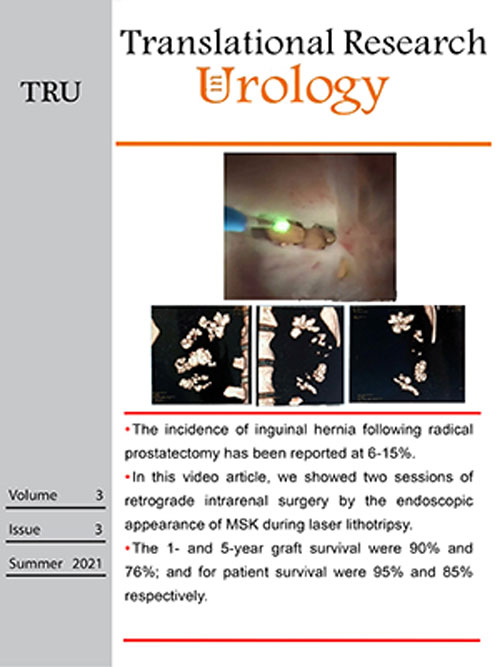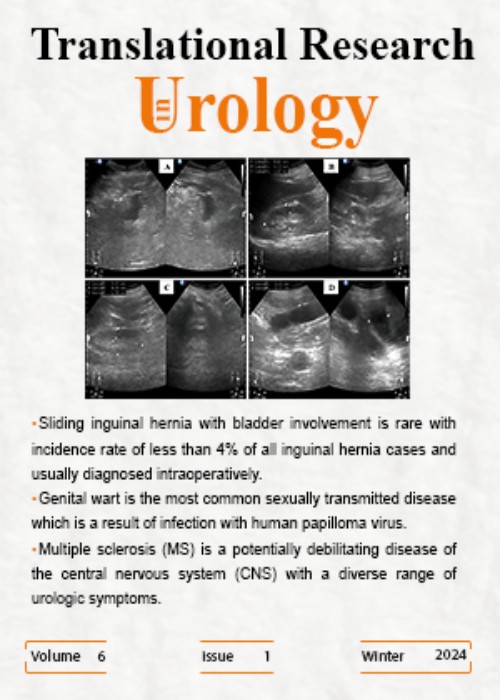فهرست مطالب

Journal of Translational Research in Urology
Volume:1 Issue: 2, Autumn 2019
- تاریخ انتشار: 1398/08/14
- تعداد عناوین: 8
-
Pages 51-53
The prospective cohort study investigated the association between postoperative infectious complications in patients undergoing urologic procedures based on the presence of asymptomatic bacteriuria (ASB). The advantages of this study are not only the method of blinding by using alternative infectious diseases physicians but also the idea was unique. When we read this article, we thinking about more important risk factors rather than ASB. Although This study was approved by the Universidad CES Research Ethics Committee, we should think about its ethical problems.
Keywords: urology procedure, urology, urine culture -
Pages 54-57Introduction
The abdominal emphysematous pyelonephritis and its association with lung involvement in diabetic patients can be life treating and should be the cure as soon as possible.
Case presentationOur case is a 39-year-old female patient with diabetes mellitus with a history of left kidney stones. She underwent extracorporeal shock wave Lithotripsy (ESWL) and a week later referred to the emergency room because of glucose 389 mg/dL, fever, and renal abscess. The infection then developed as emphysema around the kidneys and lungs and subsequent studies of urine sample tests confirmed the infection with E-Coil. Following this parenchymal infection, the left kidney was destroyed and developed above the abscess diaphragm, and the left lung collapsed causing progressive emphysematous (PELE). The patient underwent the necessary diagnostic and therapeutic measures, including glycemic control and surgery thoracoabdominal incision with left nephrectomy, abscess drainage, and decortications. Eventually, the patient was discharged in good general condition.
ConclusionsIn our case, auto-nephrectomy caused by pyelonephritis occurred in the context of diabetes and with a history of renal stone, so it seems that diabetic patients should also consider auto-nephrectomy in severe chronic and acute pyelonephritis infection.
Keywords: Progressive Emphysematous Loculated Empyema, Emphysematous pyelonephritis, extracorporeal shock wave lithotripsy -
Pages 58-60
The new technique of laser applications with flexible ureteroscopy and retrograde intrarenal surgery (RIRS) applications has improved a lot over the last few years. Nowadays, it is possible to effectively accomplish RIRS operations on upper urinary system stones by using devices that yield high-quality images due to developments of digital technology as well as increased deflection ability. Several modifications and suggestions are considered for its improvement. One of them is using α-blockers to boost the spontaneous passage of ureteral stones led and relaxation and to decrease intramural ureteral resistance in ureteral smooth muscles.
Keywords: Retrograde Intrarenal Surgery, Alpha Blockers, ureteral access sheaths -
Pages 61-66
Overactive bladder (OAB) is a common urinary disorder that affects both sexes. This disorder has a very strong and direct effect on the quality of the personal and social life of patients. Some recent studies have shown that urine and urinary tract are not sterile and contain special microbiota (communities of special microorganisms that are found in and on an individual). Thus, the goal of this review was to answer the question of whether microbiota can lead to an overactive bladder.
Keywords: Overactive bladder, Microbiota, Urinary tract, 16S rRNA, Metagenomic sequencing -
Pages 67-73
Today, prostate cancer is the second leading cause of death in men. Disorders of this gland have side effects on fertility and cause urinary problems. As people age, the prostate gland can have some problems, including benign hyperplasia and prostate cancer, which are caused by abnormal growth of the gland. Various natural supplements that affect the growth and proliferation of prostate cells have been found using epidemiological, laboratory, and clinical studies. With the help of findings from herbal medicine, the problems caused by prostate disorders can be controlled and treated largely. In this review article, the mechanism of action of some of these natural substances is considered including garden thyme, spirulina algae, Ruta graveolens L, wheat germ, nettle root extract Urtica dioica, lycopene, saw palmetto, garlic, curcumin, pumpkin seeds, green tea, and soy. The main functional mechanism of most of these plant extracts may be the inhibition of the enzyme 5 alpha-reductase. This enzyme converts testosterone to dihydrotestosterone, which causes dihydrotestosterone to cause carcinogens in the prostate. The purpose of writing this article is to introduce and use some medicinal plants that help treat prostate cancer.
Keywords: herbal extracts, Prostate cancer treatment, Prostate Cancer -
Pages 74-78Introduction
Primary retroperitoneal mucinous cystadenoma is a rare tumor among women. Herein, we present a 47-year-old Iranian woman complaining of abdominal discomfort for six months.
Case presentationThe patient and her family had always lived an urban life and they didn’t have any close contact with farm animals and their products. She didn’t mention any history of malignant or benign abdominal tumors in her first-degree relatives. The primary evaluation showed normal lab data but a huge retroperitoneal cyst in imaging studies. The patient underwent an exploratory laparotomy. A 19x14x8 cm well-defined cystic lesion with mild adhesion to the lower pole of the left kidney and descending colon was noticed. The mass was dissected from the adjacent organs and removed completely without spillage of its content. The histopathologic evaluation of the cyst was compatible with retroperitoneal mucinous cystadenoma. Three years’ follow-up did not show any recurrence of the tumor. To our knowledge, less than 50 cases with this pathology have been reported and published in the literature and this case is the second one in Iran.
ConclusionsAlthough primary retroperitoneal mucinous cystadenoma is a very rare entity, it should be considered in the differential diagnosis of any retroperitoneal cystic lesion. Since the definitive diagnosis of these lesions is made by histopathologic evaluation, complete resection of them is both diagnostic and therapeutic.
Keywords: Retroperitoneal cyst, cystadenoma, mucinous, case reports -
Pages 79-83Introduction
Stone impaction in ureteral is defined as an unchanged stone location for at least 2 months or an inability to pass guidewire up to the stone intraoperatively. This study aims to evaluate the effect of stone impaction on pneumatic transurethral lithotripsy in upper ureteral stones. And to assess if stone impaction could be a factor that prevents retropulsion of upper ureteral stones.
MethodsIn this retrospective cohort study, patients referred with upper ureteral stone to the urology clinic of Sina hospital between May 2014 to May 2018 were evaluated. The patients were divided into two groups: those with stone impaction (Group A) and those without impaction of stone (Group B). Transurethral lithotripsy (TUL) procedure with pneumatic lithotripter was performed in all patients. The data were extracted from patients’ documents and files retrospectively and analyzed. Quantitate data were shown by the number (%) and they were compared by chi-square test.
Results70 patients with upper ureteral stones were evaluated. 38 patients (54.2%) in group A and 32 (45.7%) in group B. Average stone size was 7 mm (5-12) and there wasn’t a significant difference in stone burden between the two groups. Stone-free rate (SFR) was significantly less in group B. (90% in group A versus 19% in group B, p-value <0.001). Almost 1.7% of patients experienced complications, there wasn’t a significant difference between the two groups.
ConclusionsBased on the better success rate of pneumatic TUL in upper ureteral impacted stones in comparison with non-impacted stones, we could conclude that having an impacted stone could be a favorable risk factor for successful TUL. The reason could be less migration of these types of stones.
Keywords: Ureteral Calculi, pneumatic, Lithotripsy, Impaction -
Pages 84-90Introduction
After kidney transplantation, several factors should be checked to predict the risk of rejection. Liver enzymes are such predicting factors so liver function test abnormalities (LFTA) can consider the rejection possibility in kidney transplant recipients (KTR).
MethodsThrough a retrospective cohort study, 659 KTR were studied. The source of all grafts was from deceased donors. Amongst these cases, 67 patients showed a significant rise in creatinine as the rejection indication. Several liver indexes like alanine transaminase (ALT), aspartate transaminase (AST), direct bilirubin (Bil D), total bilirubin (Bil T), and liver ultrasound reports, gamma-glutamyl transpeptidase (GGT), alkaline phosphatase (ALP), prothrombin time (PT) INR in addition to creatinine were examined for three-six post-transplant in KTR.
ResultsOur study exposed that liver functional tests regularly had considerable statistical differences between KTR with creatinine increase and with no creatinine increase. Despite these differences between the two groups AST, ALT and ALP serum levels were still within the normal range in both groups. The same result was seen over Bil D and Bil T.
ConclusionsLiver function test abnormalities can not adequately predict the rejection. Some other elements should be taken into consideration like inflammation factors like erythrocyte sedimentation rate (ESR or sed rate), and C-reactive protein (CRP).
Keywords: Kidney Transplantation, Liver function test, Creatinine, Allografts


